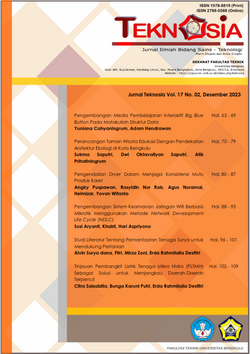Main Article Content
Abstract
A micro hydro power plant (MHPP) is a small-scale power plant that converts the potential energy of the air into mechanical work, turning turbines and generators to generate electrical power. Small scale, which is around 0-100 kW. The construction of a Micro-hydro Power Plant (MHPP) is an alternative supply of electrical energy, especially in rural areas that are not covered by the electricity grid State Power Plant. MHPP has a high potential as an alternative to renewable energy sources. Thus, the reliability of the system built is a must forget quality electricity. In a power plant, what is considered is the stability of the output voltage generated by the generator; this is necessary to keep the consumer's equipment from being damaged. Unstable voltage can also Age-reduce equipment (lifetime) owned by consumers.
Keywords: Micro Hydro Power Plant 2; Alternative, 3; Electric Power
Article Details
Copyright (c) 2023 Erda Desfitri, Citra Salsabilla, Bunga Putri

This work is licensed under a Creative Commons Attribution-ShareAlike 4.0 International License.
Authors who publish with this journal agree with the following terms:
- Authors retain copyright and grant the journal the right of first publication with the work simultaneously licensed under a Creative Commons Attribution License that allows others to share the work with an acknowledgement of the work's authorship and initial publication in this journal.
- Authors are able to enter into separate, additional contractual arrangements for the non-exclusive distribution of the journal's published version of the work (e.g., post it to an institutional repository or publish it in a book), with an acknowledgement of its initial publication in this journal.
- Authors are permitted and encouraged to post their work online (e.g., in institutional repositories or on their website) prior to and during the submission process, as it can lead to productive exchanges, as well as earlier and greater citation of published work (See The Effect of Open Access).
- This work is licensed under a Creative Commons Attribution-ShareAlike 4.0 International License.
References
-
NURHIDAYAH, C., et al. Analisis Potensi Pembangkit Listrik Tenaga Mikrohidro Di Air Terjun Gollae Kabupaten Pangkep. VERTEX ELEKTRO, 2022, 14.2: 52-59.
Shofiyah, O., Gunandar, C. M., & Ariyanti, V. T. D. (2023). Efektivitas pembangkit listrik tenaga mikrohidro sebagai penyedia energi baru terbarukan berbasis komunitas:(Studi Kasus: PLTMH Anggi, Kabupaten Pegunungan Arfak dan PLTMH Kali Ombak, Kabupaten Maybrat, Papua Barat). Social, Ecology, Economy for Sustainable Development Goals Journal, 1(1).
Sinaga, L. A. G., & Prayogi, E. (2022). PROSES PERAKITAN DAN PENGUJIAN PEMBANGKIT LISTRIK TENAGA MIKRO HIDRO DENGAN TURBIN CROSSFLOW. JURNAL ILMIAH TEKNIK MESIN, 10(2), 67-73.
Subandono, A. (2013). Pembangkit listrik tenaga mikrohidro (pltmh). J. Rekayasa Elektr, 10(4), 1-13.
Nugroho, H. A., & Sunardi, S. (2017). Perancangan dan Pembangunan Pembangkit Listrik Tenaga Mikro Hidro. J. Ilm. Tek. Elektro Komput. Dan Inform, 3(2).
Purnama, A. (2011). STUDI KELAYAKAN PEMBANGUNAN PEMBANGKIT LISTRIK TENAGA MIKROHIDRO Studi Kasus: PLTMH Minggir pada saluran irigasi Minggir di Padukuhan Klagaran Desa Sendangrejo Kecamatan Minggir Kabupaten Sleman. Jurnal Unsa Progress, 10(15).
Doda, N., & Mohammad, H. (2018). Analisis potensi pengembangan pembangkit listrik tenaga mikrohidro di Kabupaten Bone Bolango. Gorontalo Journal of Infrastructure and Science Engineering, 1(1), 1-10.
Suarda, M. (2009). Kajian teknis dan ekonomis potensi pembangkit listrik tenaga mikro-hidro di Bali. Jurnal Ilmiah Teknik Mesin CakraM, 3(2), 184-193.
Hadiyanto, R., & Bakrie, F. (2013, October). Rancang bangun prototipe portable mikro hydro menggunakan turbin tipe cross flow. In Prosiding Seminar Nasional Fisika (E-JOURNAL) (Vol. 2, pp. 19-25).
Suryono, E., & Nusantara, A. E. B. (2017). Simulasi turbin crossflow dengan jumlah sudu 18 sebagai pembangkit listrik picohydro. Simetris: Jurnal Teknik Mesin, Elektro dan Ilmu Komputer, 8(2), 547-552.
References
Shofiyah, O., Gunandar, C. M., & Ariyanti, V. T. D. (2023). Efektivitas pembangkit listrik tenaga mikrohidro sebagai penyedia energi baru terbarukan berbasis komunitas:(Studi Kasus: PLTMH Anggi, Kabupaten Pegunungan Arfak dan PLTMH Kali Ombak, Kabupaten Maybrat, Papua Barat). Social, Ecology, Economy for Sustainable Development Goals Journal, 1(1).
Sinaga, L. A. G., & Prayogi, E. (2022). PROSES PERAKITAN DAN PENGUJIAN PEMBANGKIT LISTRIK TENAGA MIKRO HIDRO DENGAN TURBIN CROSSFLOW. JURNAL ILMIAH TEKNIK MESIN, 10(2), 67-73.
Subandono, A. (2013). Pembangkit listrik tenaga mikrohidro (pltmh). J. Rekayasa Elektr, 10(4), 1-13.
Nugroho, H. A., & Sunardi, S. (2017). Perancangan dan Pembangunan Pembangkit Listrik Tenaga Mikro Hidro. J. Ilm. Tek. Elektro Komput. Dan Inform, 3(2).
Purnama, A. (2011). STUDI KELAYAKAN PEMBANGUNAN PEMBANGKIT LISTRIK TENAGA MIKROHIDRO Studi Kasus: PLTMH Minggir pada saluran irigasi Minggir di Padukuhan Klagaran Desa Sendangrejo Kecamatan Minggir Kabupaten Sleman. Jurnal Unsa Progress, 10(15).
Doda, N., & Mohammad, H. (2018). Analisis potensi pengembangan pembangkit listrik tenaga mikrohidro di Kabupaten Bone Bolango. Gorontalo Journal of Infrastructure and Science Engineering, 1(1), 1-10.
Suarda, M. (2009). Kajian teknis dan ekonomis potensi pembangkit listrik tenaga mikro-hidro di Bali. Jurnal Ilmiah Teknik Mesin CakraM, 3(2), 184-193.
Hadiyanto, R., & Bakrie, F. (2013, October). Rancang bangun prototipe portable mikro hydro menggunakan turbin tipe cross flow. In Prosiding Seminar Nasional Fisika (E-JOURNAL) (Vol. 2, pp. 19-25).
Suryono, E., & Nusantara, A. E. B. (2017). Simulasi turbin crossflow dengan jumlah sudu 18 sebagai pembangkit listrik picohydro. Simetris: Jurnal Teknik Mesin, Elektro dan Ilmu Komputer, 8(2), 547-552.
